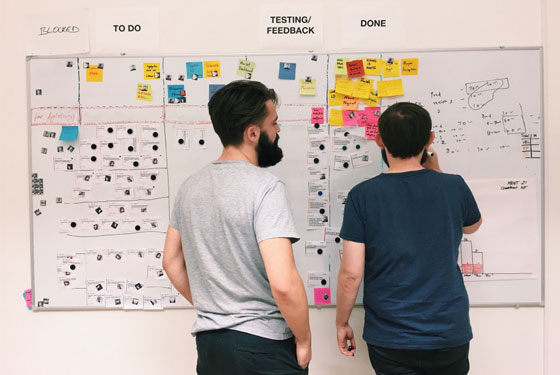
Scrum is precisely an evolution of Agile Project Management. It is an agile development methodology used for developing, delivering and sustaining products in a complex environment. It lets you have a set of meetings, tools, and roles for helping teams structure and manage their tasks. This effective, flexible and fast framework encourages teams to work together and deliver value to customers throughout the project development process.
The intent of using Scrum is to meet clients’ requirements with transparent communication, continuous progress and collective responsibility. Scrum also points to team wins and losses for improvement. What else? Scrum is mostly utilized by software development teams. However, its lessons and principles can easily be applied to different teamwork in various areas such as research, sales, marketing and advanced technologies. This is what makes scrum so popular.
Scrum Methodology & Process
When it comes to Scrum methodology, we can’t deny that this methodology has been developed, based on a set of very defined practices and roles – in fact, the practices and roles that are involved during the software development process.
- Scrum is implemented in temporary blocks that are short and periodic, called Sprints.
- The period of Sprint can be from 2 to 4 weeks, which is the term for feedback and reflection.
- Each Sprint is an entity in itself. It provides a complete result, a variation of the final product that can be delivered to the client with the least possible effort when requested.
Scrum allows companies to achieve short development cycles and meet the demand of customers without compromising on quality work. This easy-to-use Scrum methodology is used primarily for software development. However, other sectors can also reap the benefits from it.
Different Roles in Scrum
In Scrum, your developers can focus on building quality software. The owner of a scrum project can focus on defining the qualities that the project must-have for building and overcoming any challenges that could affect the task of the development team.
Roles of Scrum Team includes the following:
“It is the Scrum Master’s job to guide the team toward continuous improvement – to ask with regularity, “How can we do what we do better?” – Jeff Sutherland
- Scrum Master: Scrum Master is the person whose roles include coaching the team members in self-management and cross-functionality. He leads the team and guides them to adhere to the rules of the methodology. He works with the Product Owner to boost the ROI. Further, Scrum Master ensures that all events take place correctly on time and are positive, productive. His accountability also includes keeping Scrum up to date, providing mentoring, coaching, and training to the teams.
- Product Owner: Also referred to as PO, the Product Owner is typically a project’s key stakeholder or we can say representative of customers and stakeholders that use the software. He has the vision about what to be built and conveys that vision to the scrum team. PO is engaged with the business part and is responsible for the project ROI. He explains the project vision, validates the benefits in stories to be included in the product backlog and prioritizes them regularly.
- Scrum Team: Scrum is a group of experts working together to deliver the requested and committed product increments. Scrum experts have technical expertise in developing the project jointly and carrying out the stories they commit to at the beginning of each sprint. Within the Scrum Framework, all work delivered to the client is accomplished by the Scrum team. For effective results, following a common goal is important for everyone within the team.
Benefits of Scrum Methodology
The benefits of Scrum over other agile development methodologies are manifold. Lately, it is the most trusted and used framework of reference in the software development industry. Key benefits of Scrum include:
- Easily Scalable: Scrum processes are iterative. They can be handled within specific work periods, which can be convenient for the team to focus on definite functions for each period. This leads to achieving better deliverables according to the needs of users. It enables teams to scale the modules in terms of design, functionality, design, scope and characteristics in an orderly, transparent and simple manner.
- Flexible to Changes: Flexibility of making changes in requirements as per customer needs or market developments is another benefit. The Scrum methodology is built up in a way to adapt to the changing requirements that complex projects entail.
- Time to Market Reduction: The client will be able to use the most important functionalities of the project before the project is completely ready.
- Better Software Quality: In scrum, better software quality can be achieved due to the working method and the option to obtain a functional version after each iteration.
- Timely Prediction: With this methodology, you can know how fast your team can work (their average speed) by a sprint (story points) and can rest assured when a certain functionality that is still in the backlog can be achieved.
- Reduction of Risks: The feature to carry out the most valuable functionalities first and know the team speed in advance in the project allows to eliminate risks in advance.
Events in Scrum or Ceremonies
Key ceremonies or events of a scrum team are as follow:
- Sprints: Sprint is the basic unit of work for a Scrum team. It is predefined length events of one month or less for creating consistency. A new Sprint starts quickly after the previous Sprint concludes. Everything related to development, planning, review, etc. to achieve the product goal can happen within Sprints.
Keeping Sprint short is advisable because if it is long, it may become invalid and complexity may rise. Shorter sprints can be easily implemented, used to generate more learning cycles and reduce risks of costs and efforts. Each Sprint may be a short project.
- Sprint Planning: Sprint planning is a collaborative effort involving a ScrumMaster and Product Owner and the Entire Agile Team. The goal is to determine what is to be delivered in the Sprint and how it should be done. The ScrumMaster organizes a meeting at the start of each Sprint in which the Product Owner clarifies and explains the product backlog items and their respective acceptance criteria.
The project that comes from the Product Backlog stages and the deadline is outlined. The entire Agile Team defines the work and effort necessary to meet their sprint commitment. Please note that every Sprint comes with different features.
- Daily Scrum: Daily Scrum is a 15-minute event for Developers of the Scrum Team. Its goal is to reduce the complexity. It is organized at the same time and placed every working day of the Sprint. Further, Daily Scrum assesses the progress and trend till the Sprint ends. It synchronizes the activities and creates a plan for the next 24 hours. If the Scrum Master or Product Owner are actively working on items in the Sprint Backlog, they participate as Developers. What is more? Three questions are answered individually. These questions are –
- What did I do yesterday?
- What am I going to do today?
- What help do I need?
- Sprint Review: In Scrum, each sprint delivers a potentially shippable product increment. That’s why, at the end of each sprint, a sprint review meeting is organized to showcase all the work that has been completed. The finished sprint is reviewed. In this sprint, a very clear and tangible advancement in the product is presented for the client to see. Typically Sprint Review takes the form of a demo of the new features.
- Sprint Retrospective: It is a recurring meeting, held at the end of a sprint. The goal is to focus on what went well during the previous sprint cycle and what needs improvement for the next sprint. This stage implements improvements in the development process. In fact, the goal is to detect possible process improvements and generate a plan for implementing them in the next Sprint. It is among the most essential parts of the Scrum framework to develop, deliver, and manage complex projects.
Scrum Artifacts
“The goal of retrospectives is to help teams to continuously improve their way of working.” – Ben Linders
Scrum Artifacts bring transparency to the key information that a scrum team uses to understand the product that is being developed. Based on this, the team also evaluates actions performed during the project. The main agile scrum artifacts are Product Backlog, Sprint Backlog, and Increments.
- Product Backlog (PB): It contains everything that the product requires for satisfying potential customers. Prepared by the product owner, the functions are prioritized according to what is more and less important for the business. PB’s goal is to let the product owner answer the question “what should be done.”
- Sprint Backlog (SB): It is a subgroup of items from the product backlog. The team selects these items to perform during the sprint in which they are going to work. They set the duration of each Sprint. In general, the sprint backlog is displayed on physical boards called Scrum boards that make the development process visible to everyone who enters the development area.
- Increment: It is the sum of all the tasks, user stories, user cases, product backlogs and any element that was built during the sprint and that will be made available to the end-user in the form of Software.
Planning in Scrum
All the team members including the Product Owner, Scrum Master and Development Team participate hold a meeting at the beginning of each Sprint. All members should be aware of the Sprint Goal.
This is the point where the development team designs a plan to achieve the Sprint Goal. This planning allows you to confirm whether or not the sprint goal has a workload as per the duration stipulated for the Sprints. The stipulated duration is 2 to 4 weeks).
In the planning, the client lets you know the results to be achieved in that Sprint. He also explains the requirements for the deliverable product. Then, you need to discuss with the development team to evaluate what elements of the list can be delivered.
The Scrum Master and the Product Owner are required to collaborate and clarify any aspect of the requirements. Finally, the development team needs to explain how they will manage to organize the team’s work to achieve the Sprint Goal.
Now that you are familiar with Scrum Methodology and know how it helps. Are you interested in implementing it in your business?

